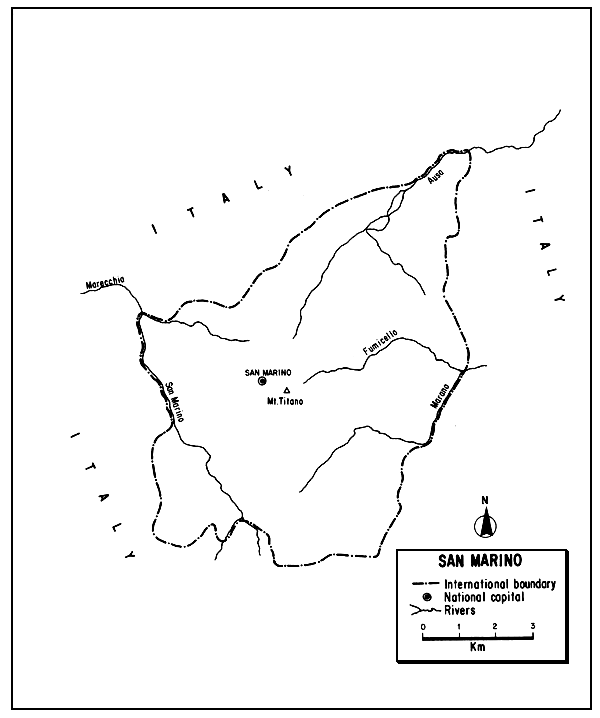
The Most Serene Republic of San Marino is the third smallest country in Europe, the oldest republic in the world, and (next to Nauru) the smallest republic in the world. A tiny enclave, perched on a mountain in north-central Italy, San Marino supports itself primarily through agriculture and tourism, including the sale of postal stamps and wine.
It is reported that there is some fishing (undoubtedly angling) in the Republic.
| 1. | AREA: | 61 km2 | |
| 2. | POPULATION: | 23 000 (est. 1985) | Density: 377 inh/km2 |
| 3. | PHYSICAL GEOGRAPHY | ||
San Marino is an enclave in north-central Italy between the Italian regions of Emilia-Romagna and the Marches. At 43°56'N latitude and 12°27'E longitude, it is about 25 km inland from Rimini on the Adriatic Sea. It has a maximum length (S-NE) of 12.6 km, maximum breadth (E–W) of 8.6 km, and a boundary of 39 km.
Situated on the slopes and summit of a sandstone ridge of the Apennines, Mount Titano, there are level areas for agriculture at the base of the mountain which attains a height of 749 m.
4. CLIMATE
Generally mild in winter, although frequently below freezing, it is warm and pleasant in summer. The range in air temperature is from -2° to 30°C. Rainfall is moderate, about 890 mm per year.
5. HYDROGRAPHY AND LIMNOLOGY
San Marino is in the Adriatic drainage between the valleys of the Marecchia to the north and the Conca to the south. The waters of the southwestern section are collected by the torrent of San Marino which forms a partial boundary, and flows northward to join the Marecchia River. The eastern section drains to the Ausa River toward the north and the Marano, which forms a partial eastern boundary, toward the south.
6. LAND AND WATER USE
About one-fifth of the population lives in the capital city of San Marino, and the country is considered essentially as urban.
About 17 percent of the country is considered to be arable according to the 1987 FAO Production Yearbook. Farming is the most important use of the land. Maize, wheat, grapes, and fruit are cultivated, and livestock are also raised. Some wood is cut and some stone is mined. Electric power is imported. There is a little light industry: cotton textiles, leather, paper, brick, tile, tanning, ceramics and souvenirs.
Transport is by auto road, bus and railway to the coast. Tourism in this picturesque republic is a major source of income.
7. FISH AND FISHERIES
During the 1965–87 period, the FAO Yearbooks of Fishery Statistics have dubbed the fisheries of San Marino variously as “nil”, “negligible”, “insignificant”, “none”, or “zero”, and of San Marino, Worldmark (1988) says “There is no fishing”.
With a paucity of water, one might assume that there would be little or no fishing in the enclave. However, Europe (1984) says: “There are facilities for shooting, fishing and various other recreations”, and Polk (1985) says: “Hunting, fishing and swimming are available in season…”
8. OWNERSHIP AND ADMINISTRATION OF FISHERIES
No information on this subject has been available.
9. STATE OF THE FISHERY
It is obviously slight since the waters are of the type known in Italy as “torrenti”.
10. REFERENCES SPECIFIC TO SAN MARINO
Polk, P., 1985 Tiny countries, big attractions. San Francisco Examiner, 26 May 1985, Travel Section, pp. 8–9